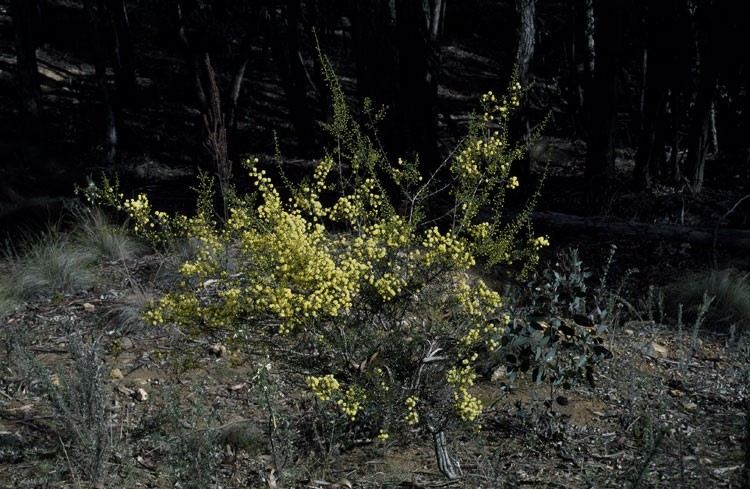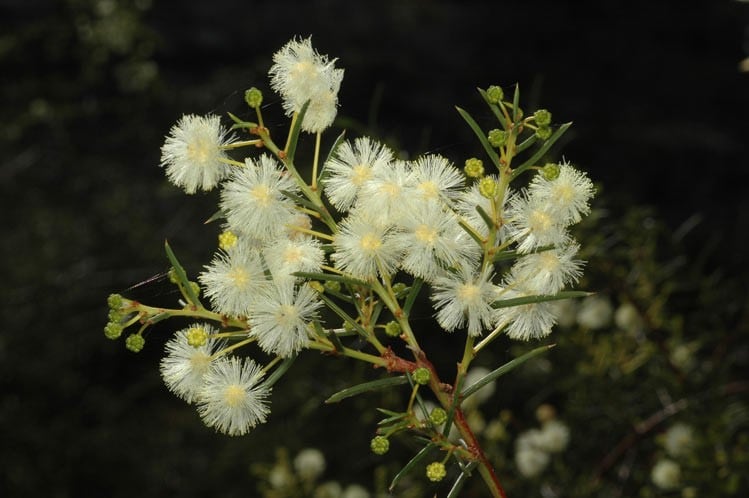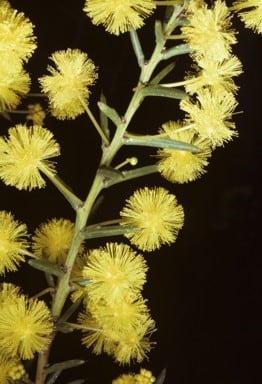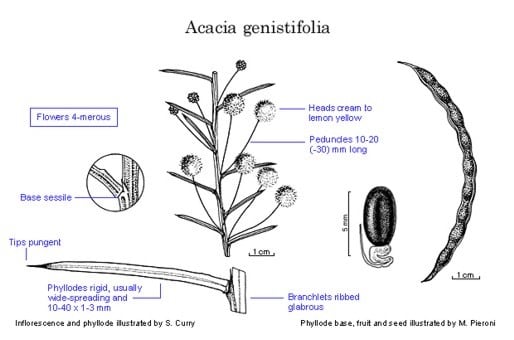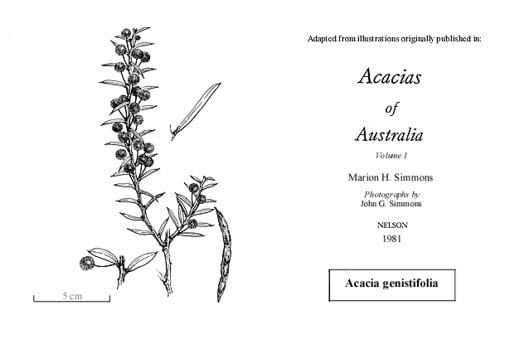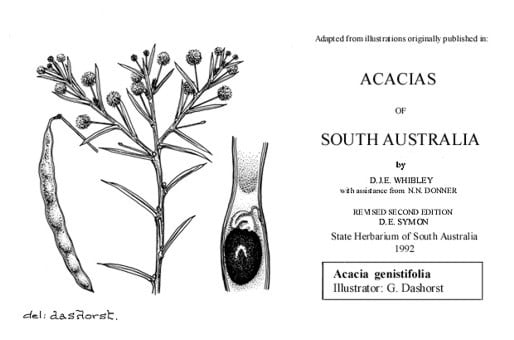Acacia genistifolia Link
WATTLE
Acacias of Australia
Common Name
Spreading Wattle, Early Wattle
Family
Fabaceae
Distribution
Common in south-eastern Australia from Dubbo, N.S.W., S through A.C.T. to the Grampians, Vic.; rare in S.A. (N of Mintaro); abundant in N and E Tas., including Flinders and Bruny Islands.
Description
Open often straggly shrub usually 0.6–3 m high, glabrous. Branchlet apices ribbed; ribs normally yellow. Stipules sometimes caducous, c. 1 mm long. Phyllodes subdistant, sessile, usually patent to inclined, rather coarse, straight to shallowly recurved, quadrangular to (especially in Tas.) flat, usually 1–4 cm long and 1–3 mm wide, pungent with slender cusp, rigid, green, 4-nerved in all, prominently 1-nerved per face when flat, occasionally imperfectly 2- or 3-nerved; gland 2–4 mm above base. Inflorescences simple, usually 2–4 per axil; peduncles 1–2 (-3) cm long, rather slender; basal bract caducous; heads globular, 12–30-flowered, cream to rich lemon yellow. Flowers 4-merous; sepals c. 2/3-united. Pods linear, raised over seeds, arcuate to ±straight, 4–11 cm long, 4–7 mm wide, thinly coriaceous. Seeds longitudinal, 3.5–5.5 mm long; aril terminal.
Habitat
Grows in a variety of soils, in dry sclerophyll forest and woodland or heathland below 1000 m alt.
Specimens
S.A.: c. 10.5 km from Mintaro, on side track off Gap Rd, D.E.Symon 15038 (AD, PERTH). A.C.T.: along Weetangera road N of Black Mtn, R.D.Hoogland 6418 (CANB). N.S.W.: 13.4 km E of Bathurst, R.Coveny 4149 (K, NSW, PERTH). Vic.: 14.5 km SE of Knowsley on McIvor Hwy to Heathcote, B.R.Maslin 5858 (MEL, PERTH). Tas.: hills between Forcett and Nugent, J.G. & M.H.Simmons 1705 (PERTH); 8 km N of Whitemark, Flinders Is., 29 Nov. 1952, J.Calaby s.n. (MEL).
Notes
G.Bentham, Fl. Austral. 2: 325, 332 (1864) was unsure of the application of the name A. genistifolia, referring to it under both A. trinervata and A. juniperina (= A. ulicifolia). Nomenclature and synonymy was subsequently clarified by A.B.Court, Muelleria 2: 157 (1972).
Phyllodes are usually 1–4 cm long and rather widely spreading, but occasionally (especially coastal areas from Wilson’s Promontory N to the N.S.W. border) they may be ascending to erect and may reach 8 cm long. A broad phyllode variant (to 6 mm wide) is recorded for eastern Tas., fide M.Simmons, Acacias Australia 44 (1981) (e.g. saddle below Mt Amos, T. & J.Whaite 2679, NSW).
Recent serological evidence suggest a relationship between A. genistifolia and A. verticillata; see P.Brain & B.R.Maslin (1996), Biochem. Syst. & Ecol. 24(5): 379–392.
Similar to A. aculeatissima which has variably hairy, finely ribbed branchlets and finer, narrower, usually shorter phyllodes with a well-developed pulvinus. Occurs with A. siculiformis near Little Swanport, Tas., where both species are prostrate (M.Simmons, pers. comm.); A. siculiformis has generally shorter peduncles, 5-merous flowers and narrowly oblong to oblong pods.
FOA Reference
Data derived from Flora of Australia Volumes 11A (2001), 11B (2001) and 12 (1998), products of ABRS, ©Commonwealth of Australia
Author
B.R.Maslin
Minor edits by B.R.Maslin
This identification key and fact sheets are available as a mobile application:
URL: https://apps.lucidcentral.org/wattle/
© Copyright 2018. All rights reserved.
